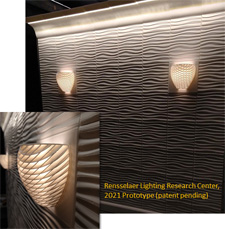3D Printing for Lighting News
Contact: N. Narendran
narenn2@rpi.edu or (518) 276-7176
Rensselaer's Lighting Research Center
demonstrates 3D-printed interior architecture with lighting
August 24, 2021
Lighting Research Center | Troy, New York

LRC prototype of 3D-printed interior architecture with lighting.
|
The 3D printing for lighting research program at Rensselaer’s Lighting Research Center (LRC) revealed today its prototype of a 3D-printed interior wall for building construction. The wall was printed at the LRC laboratory with functional and decorative features, including the mechanisms required for lighting, with the aim of creating a cohesive, whole system interior architecture that integrates all required electrical, mechanical, and thermal components.
Since 2015, LRC researchers have been exploring the opportunities and challenges of 3D-printed lighting and interiors.
Many industries, including building construction, aerospace and automotive, have begun to investigate the use of 3D printing and the possible advantages for their products and services. “3D printing offers many benefits over traditional processes in the building construction industry,” said LRC director of research Nadarajah Narendran, Ph.D. He said the expectation is that 3D printing will help construct buildings faster, cheaper, and more accurately, reducing the time and cost for both new construction and renovation.
Having walls printed on demand and on or close to the construction site can offer a cost-effective and sustainable solution for custom features. “Because these walls can be printed with the electrical, mechanical, and HVAC services all integrated, this reduces the labor-intensive interior finishing process and allows for collaboration upfront to construct a custom finished product on time with minimum waste,” said Dr. Narendran. In terms of lighting, 3D printed walls allow custom lighting to be integrated from the start rather than added-on at the end from a limited catalog selection of lighting fixtures that may or may not suit the building’s interior. And because 3D-printed products are created through computer-aided design models, wall designs can be easily modified as needed to meet different codes, standards, and aesthetics requirements. The LRC shared its prototype 3D-printed interior wall at the Strategies in Light 2021 conference.
Dr. Narendran noted that collaboration is key to gaining broad adoption of 3D-printed lighting and interiors. To realize this vision, in 2019 the LRC established the ASSIST 3D Printing for Lighting Consortium, an alliance of lighting and 3D printer and material manufacturers. “Together with the consortium members, we have already learned so much and have a better understanding of the two industries, 3D printing and lighting, and their capabilities and needs. But more work is needed to advance 3D printing technologies to meet lighting industry requirements,” he said. Currently, the LRC is seeking to expand the consortium’s membership in order to broaden the technology’s capabilities and to prepare the industry for this next revolution.
For more information about 3D printing for lighting at the Lighting Research Center and the LRC’s ASSIST 3D Printing for Lighting Consortium, visit https://www.lrc.rpi.edu/programs/solidstate/3DPrinting.asp or contact N. Narendran, email: narenn2@rpi.edu.
|


